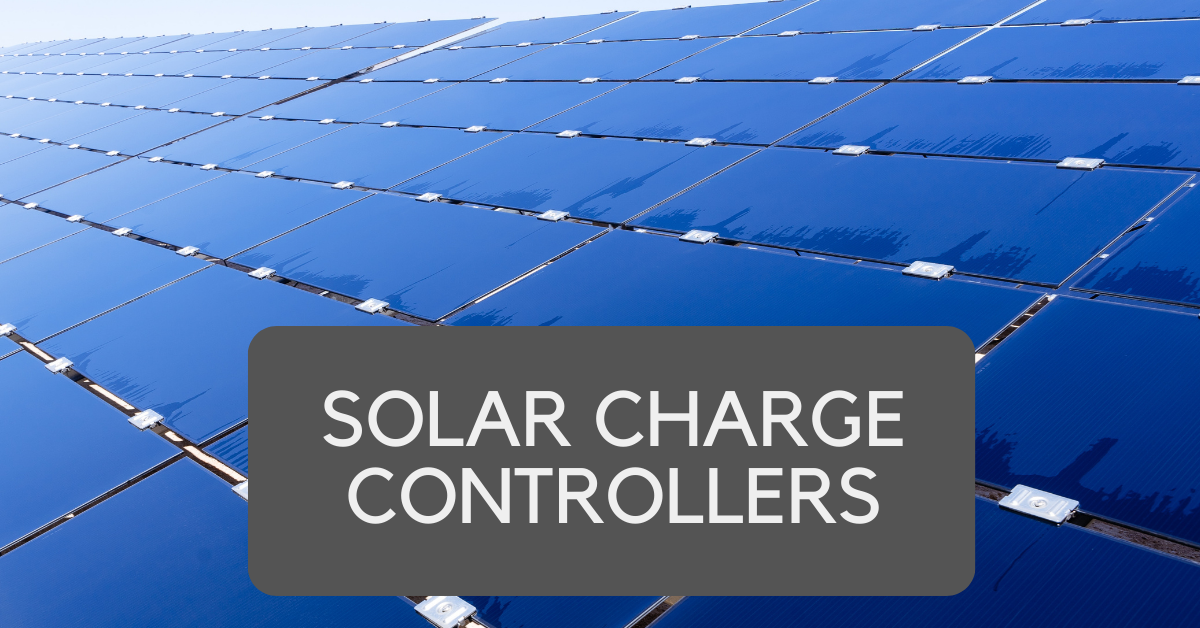In this article, we will explore the types of solar charge controllers, their uses, types, advantages and why they are a crucial component for the optimal functioning of solar systems. Solar panels harness the sun’s energy, converting it into electricity, but the efficiency and longevity of a solar power system are greatly enhanced by the use of charge controllers.
Table of Contents
- Uses of Charge Controllers
- Why the Need for Charge Controllers
- Types of Charge Controllers
- Conclusion : Final Solar Thought
The charge controller is located between the solar panel and the deep cycle battery. See below figure.
To learn more about the different solar components click this link.

Want to learn how solar panels create electricity? Read our other article by clicking this link.
Uses of Charge Controllers:
In general, charge controllers’ main function is to oversee the charging of the battery bank, preventing overcharging. Additionally, a significant number of them regulate the rate of current and voltage during the charging process. The following are more in depth explanation of their uses
Battery Protection:
Charge controllers play a crucial role in protecting the batteries within a solar power system. Overcharging and deep discharging can significantly reduce the lifespan of batteries. Charge controllers prevent these issues by regulating the voltage and current supplied to the batteries, ensuring they are charged optimally without risking damage.
System Optimization:
MPPT charge controllers, in particular, optimize the performance of solar panels by adjusting the electrical operating point to the maximum power output. This is especially important in situations where sunlight conditions fluctuate, such as during partial shading or changes in the angle of incidence.
Load Control:
Some charge controllers come equipped with load control features, allowing users to connect DC loads directly to the controller. This feature enables the charge controller to manage the power distribution between the battery and the connected load, preventing overloading and ensuring a stable power supply.
Why the Need for Charge Controllers:
Battery Longevity:
Charge controllers are essential for preserving the lifespan of batteries in solar power systems. By preventing overcharging and deep discharging, they help maintain the health of the batteries, ultimately extending their longevity and reducing replacement costs.
Increased Efficiency:
MPPT charge controllers, in particular, boost the overall efficiency of solar power systems by optimizing power output from the panels. This increased efficiency translates to higher energy production and greater cost-effectiveness over the life of the system.
System Reliability:
Charge controllers enhance the reliability of solar power systems by providing a stable and regulated flow of electricity. They protect against potential damage from electrical issues, ensuring the system operates smoothly and consistently.
Types of Charge Controllers:
PWM (Pulse Width Modulation) Charge Controllers:
PWM charge controllers are one of the earliest types used in solar systems. They regulate the charging of the battery by intermittently interrupting the flow of power from the solar panels to the battery. While cost-effective, PWM controllers are less efficient than their MPPT counterparts. A PWM charge controller pulses the power sent to the battery bank, allowing
it to do the different charging stages.
Choosing the right size for PWM charge controllers is pretty easy. You just need to make sure that the charge controller you pick is meant for the same voltage as your battery bank. First, check that the solar panel’s nominal voltage matches the battery bank’s voltage. After that, determine the size of the controller based on the battery bank. Some of PWM controllers can support multiple voltages, but most are designed for only a single voltage rating.
To sum up, charge controllers play a crucial role in solar power systems. They are essential for safeguarding batteries, making sure energy production is as efficient as possible, and improving the overall dependability of the system. As we move towards using more renewable energy, recognizing the importance of charge controllers and including them in solar setups becomes crucial for getting the most out of this eco-friendly and sustainable power source.
MPPT (Maximum Power Point Tracking) Charge Controllers:
MPPT charge controllers are more advanced and efficient compared to PWM controllers. They continuously adjust the electrical operating point of the solar panels, ensuring the maximum power output is extracted. This results in higher efficiency and energy yield, especially in conditions where sunlight intensity varies. This optimization capability can lead to a substantial increase in the array’s production, potentially boosting it by up to 30%.
An additional noteworthy benefit is that the majority of MPPT charge controllers are designed to accommodate higher voltage arrays, not like PWMs, providing flexibility and efficiency in various solar power system configurations.
Conclusion: Final Solar Thought
In conclusion, charge controllers are indispensable components in solar power systems, serving to protect batteries, optimize energy production, and enhance the overall reliability of the system. As the world continues to embrace renewable energy solutions, understanding and incorporating charge controllers into solar installations will be key to maximizing the benefits of this clean and sustainable power source.

